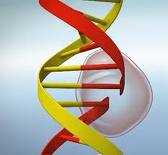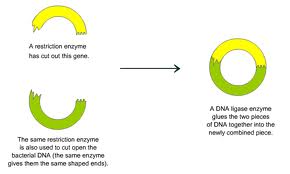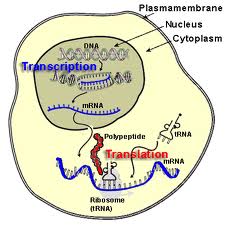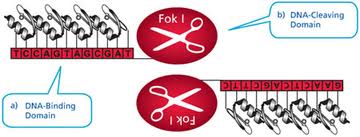 You know how to cut a paper or ribbon and paste it again with glue. Similarly, enzymes help to cut and paste DNA fragments. By this way the sequences of DNA would be modified by the enzymes. Each enzyme has its own specific function; let’s discuss one by one.
You know how to cut a paper or ribbon and paste it again with glue. Similarly, enzymes help to cut and paste DNA fragments. By this way the sequences of DNA would be modified by the enzymes. Each enzyme has its own specific function; let’s discuss one by one.
Enzymes reacts on DNA

- Nucleases
- Ligases
- Topo isomerases
- Helicases
- Polymerases
Nucleases
By catalyzing the hydrolysis of the phosphodiester bonds, these enzymes cut DNA helixes.
2 types:
1. Exonucleases - hydrolyse nucleotides from the ends of DNA strands
2. Endonucleases cut within DNA strands.
![]()
The restriction endonucleases cut DNA strands at specific sequences. To cut the DNA, a restriction enzyme makes two incisions. For example EcoRI digestion happens in the specific base sequence leaving the strand as sticky ends.
Restriction Modifications System:
Restriction enzymes protect bacteria against the bacteriophage virus infection by digesting the phage DNA which penetrates the cell. It is also used in molecular cloning and DNA fingerprinting.
Ligases:
The enzymes which rejoin the broken DNA strands are DNA ligases. Ligases are very crucial in lagging strand DNA replication. Because, they join the short DNA segments and make a complete copy of DNA Template. It is very much essential for genetic recombination and DNA repair.
Topoisomerases:
It has both nuclease and ligase activity. The amount of supercoiling in DNA can be changed by these enzymes. Some of these enzymes cut the DNA strand and rotate one section and reduce the super coiling level. Then the DNA break would be sealed by these enzymes. It is very much essential for DNA Transcription and DNA Replication.
Helicases:
These enzymes use the chemical energy ATP to break hydrogen bonds between bases. So the DNA double helix unwinds and forms two single strands.
Polymerases
It synthesizes polynucleotide chains from nucleoside triphosphates. Polymerases add nucleotides onto the 3′ hydroxyl group of the previous nucleotide in a DNA strand. So, all polymerases work in a 5′ to 3′ direction.
DNA Replication:
DNA polymerase makes a copy of a DNA sequence by a proofreading activity. Hence the accuracy is confirmed. RNA-dependent DNA polymerases copy the sequence of an RNA strand into DNA.
The enzyme reverse transcriptase involved in the infection of cells by retroviruses.
The enzyme telomerase is required for the replication of telomeres. Telomerase contains its own RNA template as part of its structure.
DNA Transcription
Transcription is controlled by RNA polymerase. This enzyme copies the DNA sequence into RNA. It binds to a promoter and separates the DNA strands. It then copies the gene sequence into a mRNA transcript until reaches the terminator and halts and detaches from the DNA segment.
RNA polymerase II transcribes the genes of human genome.
Want to know more about Enzymes? Click here to schedule live online session with e Tutor!
About eAge Tutoring:
eAgeTutor.com is the premium online tutoring provider. Using materials developed by highly qualified educators and leading content developers, a team of top-notch software experts, and a group of passionate educators, eAgeTutor works to ensure the success and satisfaction of all of its students.
Contact us today to learn more about our tutoring programs and discuss how we can help make the dreams of the student in your life come true!
